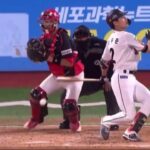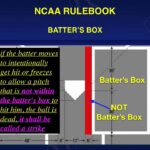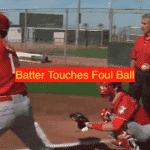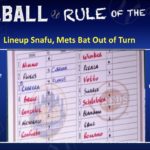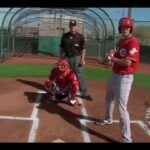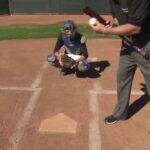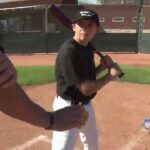Rule 7 – Section 3 – BATTING INFRACTIONS — A BATTER SHALL NOT:
7-3-1 Delay the game by failing to take his position promptly in the batter’s box within 20 seconds. The batter must keep at least one foot in the batter’s box throughout the time at bat.
EXCEPTION A batter may leave the batter’s box when:
- the batter swings at a pitch,
- the batter is forced out of the box by the pitch,
- the batter attempts a “drag bunt,”
- the pitcher or catcher feints or attempts a play at any base,
- the pitcher leaves the dirt area of the pitching mound or takes a position more than five feet from the pitcher’s plate after receiving the ball,
- a member of either team requests and is granted “Time,”
- the catcher leaves the catcher’s box to adjust his equipment or give defensive signals, or
- the catcher does not catch the pitched ball.
PENALTY: For failure of the batter to be ready within 20 seconds after the ball has been returned to the pitcher, the umpire shall call a strike. If the batter leaves the batter’s box, delays the game, and none of the above exceptions apply, the plate umpire shall charge a strike to the batter. The pitcher need not pitch, and the ball remains live.
7-3-2 Hit the ball fair or foul while either foot or knee is touching the ground completely outside the lines of the batter’s box or touching home plate.
7-3-3 Disconcert the pitcher by stepping from the box on one side of home plate to the box on the other side while the pitcher is in position ready to pitch.
PENALTY: For infraction of Articles 7-3-2 and 7-3-3, the ball becomes dead immediately and the batter is out.
7-3-4 Permit a pitched ball to touch him.
PENALTY: The batter remains at bat (pitch is a ball or strike) unless pitch was a third strike or ball four.
7-3-5 Interfere with the catcher’s fielding or throwing by:
- leaning over home plate,
- stepping out of the batter’s box,
- making any other movement, including follow-through interference, which hinders actions at home plate or the catcher’s attempt to play on a runner, or
- failing to make a reasonable effort to vacate a congested area when there is a throw to home plate and there is time for the batter to move away.
PENALTY: When there are two outs, the batter is out. When there are not two outs and the runner is advancing to home plate, if the runner is tagged out, the ball remains live and interference is ignored. Otherwise, the ball is dead and the runner is called out. When an attempt to put out a runner at any other base is unsuccessful, the batter is out and all runners must return to bases occupied at the time of the pitch. If the pitch is a third strike and in the umpire’s judgment interference prevents a possible double play (additional outs), two may be ruled out (8-4-2g).
7-3-6 If the bat breaks and is hit by the ball or hits a runner or a fielder, no interference shall be called. If a whole bat is thrown and interferes with a defensive player attempting a play, interference will be called.
PENALTY: The batter is out and runners return. If, in the umpire’s judgment, interference prevented a possible double play, two players may be ruled out.



